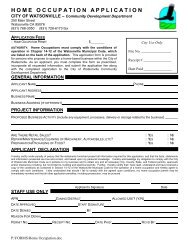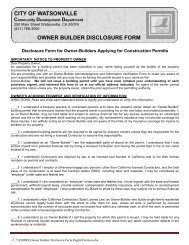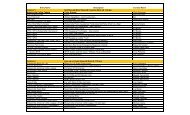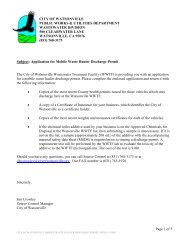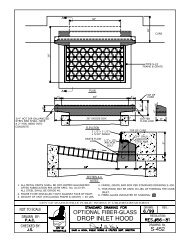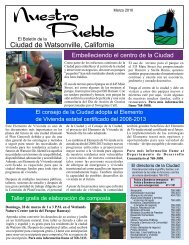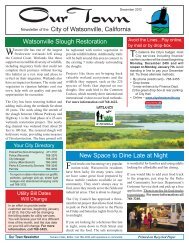Vegetation Management and Maintenance Plan - Watsonville ...
Vegetation Management and Maintenance Plan - Watsonville ...
Vegetation Management and Maintenance Plan - Watsonville ...
Create successful ePaper yourself
Turn your PDF publications into a flip-book with our unique Google optimized e-Paper software.
CHAPTER 1.0<br />
INTRODUCTION<br />
The <strong>Watsonville</strong> Wetl<strong>and</strong>s Trail System encompasses approximately six miles of multi-use<br />
recreational trails in the City of <strong>Watsonville</strong>. The trails traverse portions of <strong>Watsonville</strong> Slough<br />
<strong>and</strong> Struve Slough <strong>and</strong> abut multiple urban l<strong>and</strong> uses, including residential areas, commercial<br />
developments, school facilities, <strong>and</strong> City recreational areas. The trail system <strong>and</strong> slough areas<br />
addressed in this manual are depicted on Figure 1.<br />
The <strong>Watsonville</strong> Wetl<strong>and</strong>s Trail <strong>Vegetation</strong> <strong>Management</strong> <strong>and</strong> <strong>Maintenance</strong> Manual (VMMM)<br />
identifies the location <strong>and</strong> treatment methods to be used by the City’s maintenance personnel,<br />
contractors, <strong>and</strong>/or volunteer groups to remove <strong>and</strong>/or control the growth of weeds <strong>and</strong> invasive,<br />
non-native plant species within the trail system project area. The manual also outlines strategies<br />
to encourage native plant growth that will reduce the need for long-term weed control.<br />
The City of <strong>Watsonville</strong> has implemented several riparian <strong>and</strong> wetl<strong>and</strong> plantings along the slough<br />
trails, providing mitigation for bridge <strong>and</strong> trail improvement projects. The VMMM identifies<br />
these areas <strong>and</strong> the specific maintenance <strong>and</strong> monitoring requirements that are applicable to these<br />
mitigation plantings.<br />
1.1 STUDY METHODOLOGY<br />
1.1.1 Existing <strong>Vegetation</strong> Types <strong>and</strong> <strong>Management</strong> Areas<br />
The existing vegetation types in the VMMM project area were mapped during the City’s<br />
preparation of the Trail <strong>Plan</strong> (Swanson Hydrology & Geomorphology, 2002). Nine plant<br />
community types were observed within the trail study area. These plant communities are nonnative<br />
grassl<strong>and</strong>, blackberry scrub, ruderal (weedy) scrub, coyote brush scrub, non-native<br />
trees/tree groves, willow riparian woodl<strong>and</strong>, freshwater marsh, <strong>and</strong> seasonal wetl<strong>and</strong>s. Field<br />
surveys conducted for the VMMM confirmed the current distribution of these habitat types <strong>and</strong><br />
identified recent City-designated riparian <strong>and</strong> wetl<strong>and</strong> mitigation <strong>and</strong> enhancement areas; the<br />
distribution of the vegetation types <strong>and</strong> mitigation/enhancement areas is shown on Figures 2, 3,<br />
<strong>and</strong> 4.<br />
1.1.2 Existing Invasive Weeds, Infestation Areas, <strong>and</strong> Threat Rankings<br />
The occurrence of invasive weeds (i.e., invasive, non-native species) within the project area was<br />
identified <strong>and</strong> mapped during field surveys conducted in February, March, May, <strong>and</strong> June 2007.<br />
The infestations were mapped as line features, polygons, or spot locations by GPS or h<strong>and</strong> drawn<br />
onto aerial photos. The GPS <strong>and</strong> h<strong>and</strong> drawn data was supplied to the City’s GIS coordinator to<br />
develop a GIS data layer (i.e., “distribution of invasive weeds”). Potential vegetation management<br />
or maintenance areas were also identified, such as vegetation types or plant species that may<br />
require periodic maintenance (e.g., willow riparian woodl<strong>and</strong> that abuts a trail <strong>and</strong> pruning or<br />
other maintenance may be required now or in the future).<br />
Based on the type <strong>and</strong> extent of invasive weeds in the project area, the species/species locations<br />
were categorized as high, moderate, or low threat. A species growth pattern, extent within the<br />
project area, effect on native vegetation, <strong>and</strong> ability to spread into uninfected areas were used to<br />
<strong>Vegetation</strong> <strong>Management</strong> <strong>and</strong> <strong>Maintenance</strong> Manual<br />
Draft 1 July 27, 2007




